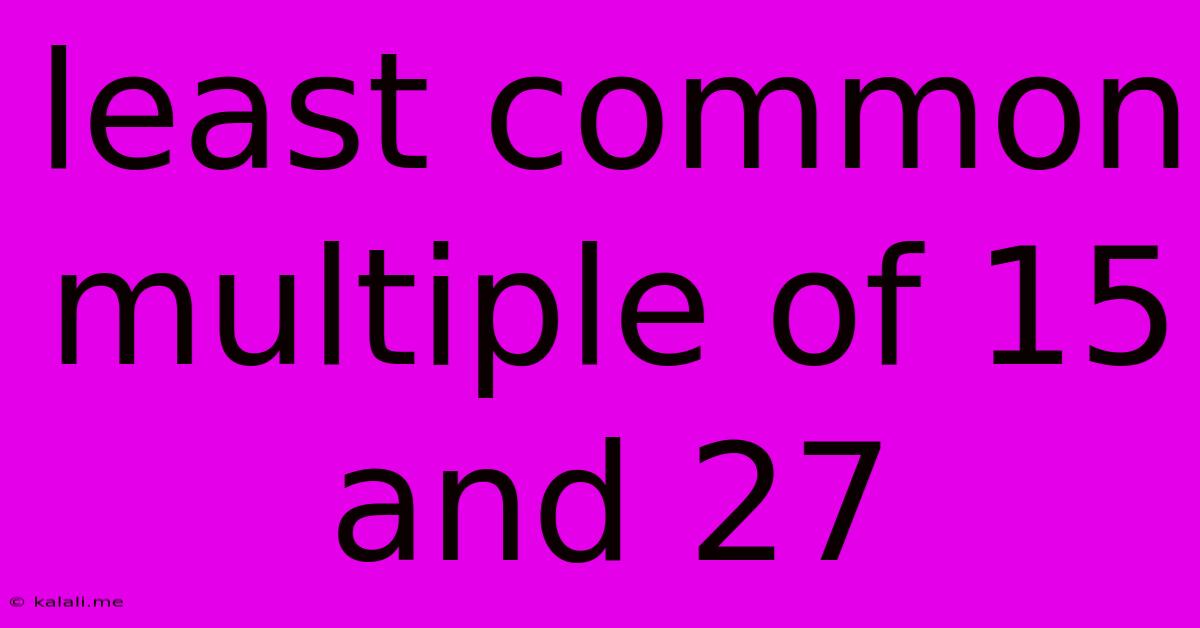Least Common Multiple Of 15 And 27
Kalali
Jun 15, 2025 · 2 min read

Table of Contents
Finding the Least Common Multiple (LCM) of 15 and 27: A Step-by-Step Guide
This article will guide you through calculating the least common multiple (LCM) of 15 and 27. Understanding LCM is crucial in various mathematical fields, from simplifying fractions to solving problems involving cyclical events. We'll explore two primary methods: prime factorization and the listing method. By the end, you'll not only know the LCM of 15 and 27 but also understand the underlying concepts and how to apply them to other numbers.
What is the Least Common Multiple (LCM)?
The least common multiple (LCM) of two or more integers is the smallest positive integer that is divisible by all the integers. In simpler terms, it's the smallest number that all the given numbers can divide into evenly. This concept is frequently used in situations involving cycles or repeating patterns, ensuring that events align at the earliest possible time.
Method 1: Prime Factorization
This method is generally considered the most efficient for larger numbers. It involves breaking down each number into its prime factors – numbers divisible only by 1 and themselves.
-
Find the prime factorization of 15: 15 = 3 x 5
-
Find the prime factorization of 27: 27 = 3 x 3 x 3 = 3³
-
Identify the highest power of each prime factor: We have a prime factor of 3 in both numbers. The highest power of 3 is 3³ (from 27). We also have a prime factor of 5 (from 15).
-
Multiply the highest powers together: LCM(15, 27) = 3³ x 5 = 27 x 5 = 135
Therefore, the least common multiple of 15 and 27 is 135.
Method 2: Listing Multiples
This method is simpler for smaller numbers but can become cumbersome for larger ones.
-
List the multiples of 15: 15, 30, 45, 60, 75, 90, 105, 120, 135, 150...
-
List the multiples of 27: 27, 54, 81, 108, 135, 162...
-
Identify the smallest common multiple: The smallest number that appears in both lists is 135.
Therefore, the least common multiple of 15 and 27 is 135.
Applications of LCM
Understanding LCM has practical applications in various areas, including:
- Fraction addition and subtraction: Finding the LCM of the denominators helps in finding a common denominator for adding or subtracting fractions.
- Scheduling: Determining when events with different repeating cycles will occur simultaneously (e.g., two buses arriving at a stop at different intervals).
- Measurement conversions: Converting between units of measurement that are not directly related.
Conclusion
Calculating the least common multiple is a fundamental mathematical skill with various applications. Both the prime factorization and listing methods provide effective ways to find the LCM, with prime factorization being generally more efficient for larger numbers. Now you can confidently tackle LCM problems, understanding the process and its practical significance. Remember to practice with different numbers to solidify your understanding!
Latest Posts
Latest Posts
-
Summarize The Main Characteristics Of The Gandhara School Of Thought
Jun 15, 2025
-
The First Step In The Research Process Is To
Jun 15, 2025
-
Suez Canal Connects Which Two Bodies Of Water
Jun 15, 2025
-
Ammeter Is Connected In Series Or Parallel
Jun 15, 2025
-
What Is A Antonym For Abundant
Jun 15, 2025
Related Post
Thank you for visiting our website which covers about Least Common Multiple Of 15 And 27 . We hope the information provided has been useful to you. Feel free to contact us if you have any questions or need further assistance. See you next time and don't miss to bookmark.